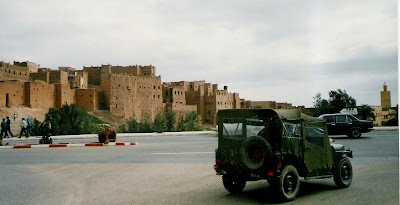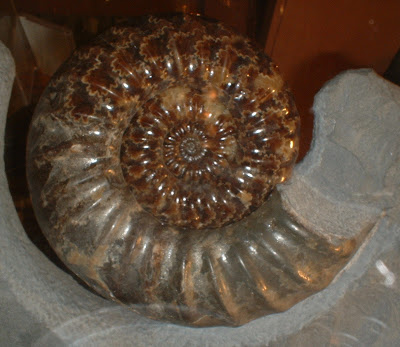
Friday 29 December 2006
NORTH AMERICAN BROWN BEAR
At age five, female (sows) grizzlies begin mating and bearing young, usually two cubs every other year. The cubs arrive over the winter and feast on their mother's milk all snuggled inside a wintery den.
The great ancestors of the North American brown bear are the Ursavus, a bear-dog the size of a raccoon who lived more than 20 million years ago. Taking a look at this beauty, it seems an implausible lineage.
Thursday 28 December 2006
Saturday 23 December 2006
Monday 11 December 2006
SHELTER POINT FOSSIL CRAB SITE
Shelter Point on northern Vancouver Island is a lovely beach site where clastic strata are exposed in the intertidal platform of Oyster Bay.
The site is located just off the Island Highway, about 10 km south of downtown Campbell River and 4 km farther south along the lower Oyster River. Haggart et al. presented an abstract on this locality at the 12th British Columbia Paleontological Symposium, 2018, Courtenay, abstracts; 2018 p. 28-30. I'll pop a link below if you'd like to give it a read.
Shelter Point has been collected since the 1970s. No pre-glacial strata were recognized in this area by Muller and Jeletzky (1970). Richards (1975) described an abundant fauna in the beds at Shelter Point, approximately 2 km north of the Oyster Bay exposures, including the crab Longusorbis and associated ammonites and inoceramid bivalves, and he assigned these beds to the Spray Formation of the Nanaimo Group. This information, combined with the very low dip of the Oyster Bay strata and their general lithological similarity with the coarse clastic strata found commonly in the Nanaimo Group, suggested a Late Cretaceous (Campanian) age of the Oyster Bay strata.
Beginning in the 1980s, fossil collectors from the Vancouver Island Palaeontological Society began amassing significant collections of fossils from the strata of southern Oyster Bay that are found several hundred metres southeast of the local road called Appian Way, thus providing the informal moniker Appian Way Beds for these localized exposures.
While these collections included a great diversity of gastropod, bivalve, nautiloid, scaphopod, echinoderm, and coral specimens, as well as impressive collections of plant materials, much previously undescribed, no taxa found commonly in Campanian strata of the Nanaimo Group were noted in these collections; particularly lacking were ammonites and inoceramid bivalves. For this reason, the hypothesis began to emerge that the Appian Way Beds of Oyster Bay were of younger, post-Cretaceous, age than thought previously.
Just how young, however, has been a source of some controversy, with different parties continuing to favour the traditional Campanian age — based on lithostratigraphy — others a Paleocene age, and still others an Eocene age — based on plant macrofossils.
Fossil Collecting at Shelter Point:
| Fossil Collecting at Shelter Point |
Industrious collectors unwilling to wait for the tide have employed rubber boots to wade through knee-deep water — rubber boots are highly recommended in any case — and even headlamps to capitalize on low tides during the night. Bring eye protection and sunscreen to safely enjoy this lovely family trip.
The fossils, mainly the crab, Longusorbis and the straight ammonite Baculites, occur only in the gritty concretions that weather out of the shale. You'll need a rock hammer to see the lovelies preserved inside. Best to hold the concretion in your hand and give it one good tap. Aside from the fossils, check out the local tide pools and sea life in the area. Those less interested in the fossils can look for seals and playful otters basking on the beaches.
References:
Haggart, J. et al. 58 million and 25 years in the making: stratigraphy, fauna, age, and correlation of the Paleocene/Eocene sedimentary strata at Oyster Bay and adjacent areas, southeast Vancouver Island, British Columbia; https://geoscan.nrcan.gc.ca/starweb/geoscan/servlet.starweb?path=geoscan/fulle.web&search1=R=308471
Saturday 9 December 2006
Tuesday 28 November 2006
BLUE JAY: KWASK'WAS
Sunday 26 November 2006
Thursday 16 November 2006
Wednesday 15 November 2006
Wednesday 8 November 2006
Monday 23 October 2006
Saturday 21 October 2006
Tuesday 17 October 2006
PREPARING FOR THE RAPIDS
 A hot meal and solid sleep leave us refreshed as we prepare to cross to the west side of the paddling route of the Bowron Lake circuit. We must first face several kilometres portaging muddy trails to meet up with the Isaac River and then paddle rapids to grade two. We enjoy a world of sensory bliss punctuated with thrilling spurts dodging stumps and snags.
A hot meal and solid sleep leave us refreshed as we prepare to cross to the west side of the paddling route of the Bowron Lake circuit. We must first face several kilometres portaging muddy trails to meet up with the Isaac River and then paddle rapids to grade two. We enjoy a world of sensory bliss punctuated with thrilling spurts dodging stumps and snags.
Saturday 7 October 2006
Saturday 9 September 2006
Tuesday 29 August 2006
EXPLORATION: LAKE ISAAC
 Like most mountainous areas, Bowron makes its own weather system and it appears you get everything in a 24-hour period. In fact, whatever weather you are enjoying seems to change 40 minutes later; good for rain, bad for sun. Wisps of cloud that seemed light and airy only hours early have become dark. Careful to hug the shore, we are ready for a quick escape from lightening as thundershowers break.
Like most mountainous areas, Bowron makes its own weather system and it appears you get everything in a 24-hour period. In fact, whatever weather you are enjoying seems to change 40 minutes later; good for rain, bad for sun. Wisps of cloud that seemed light and airy only hours early have become dark. Careful to hug the shore, we are ready for a quick escape from lightening as thundershowers break.
Monday 28 August 2006
Tuesday 11 July 2006
Friday 9 June 2006
Tuesday 16 May 2006
Monday 15 May 2006
Wednesday 10 May 2006
URSAVUS: CLOSE ENCOUNTERS
"Grizzly!" The three of us gather together to prepare for what is racing towards us.
A full-grown moose can run up to fifty-six kilometres per hour, slightly faster than a Grizzly. They are also strong swimmers. Had she been alone, Mamma moose would likely have tried to out swim the bear. Currently, however, this is not the case. From where we stand we can see the water turned to white foam at their feet as they fly towards us.
We freeze, bear spray in hand. In seconds the three were upon us. Mamma moose, using home field advantage, runs straight for us and just reaching our boats, turned 90 degrees, bolting for the woods, baby moose fast on her heels. The Grizzly, caught up in the froth of running and thrill of the kill, doesn’t notice the deke, hits the brakes at the boats and stands up, confused.
Her eyes give her away. This was not what she had planned and the whole moose-suddenly-transformed-into-human thing is giving her pause. Her head tilts back as she gets a good smell of us. Suddenly, a crack in the woods catches her attention. Her head snaps round and she drops back on all fours, beginning her chase anew. Somewhere there is a terrified mother moose and calf hoping the distance gained is enough to keep them from being lunch. I choose to believe both moose got away with the unwitting distraction we provided, but I’m certainly grateful we did.The Lakes are at an elevation of over 900 m (3000 ft) and both grizzly and black bear sightings are common. Both bear families descend from a common ancestor, Ursavus, a bear-dog the size of a raccoon who lived more than 20 million years ago. Seems an implausible lineage having just met one of the larger descendents.While we’d grumbled only hours earlier about how tired we were feeling, we now feel quite motivated and do the next two portages and lakes in good time.
Aside from the gripping fear that another bear encounter is imminent, we enjoy the park-like setting, careful to scan the stands of birch trees for dark shapes now posing as stumps.
Fortunately, the only wildlife we see are a few wily chipmunks, various reticent warblers and some equally shy spruce grouse.
Friday 21 April 2006
Thursday 13 April 2006
Saturday 11 February 2006
Saturday 28 January 2006
HORNBY ISLAND: LAMBERT FORMATION
 The fossils of Hornby Island off the coast of Vancouver Island contain some of the best preserved fossils in British Columbia. Many species of ammonites (mainly Pachydiscus), crabs, bivalves, sharks teeth, echinoids, wood and bone can be found in the Cretaceous shales and concretions of the Lambert Formation at Collishaw Point
The fossils of Hornby Island off the coast of Vancouver Island contain some of the best preserved fossils in British Columbia. Many species of ammonites (mainly Pachydiscus), crabs, bivalves, sharks teeth, echinoids, wood and bone can be found in the Cretaceous shales and concretions of the Lambert Formation at Collishaw Point







.png)













